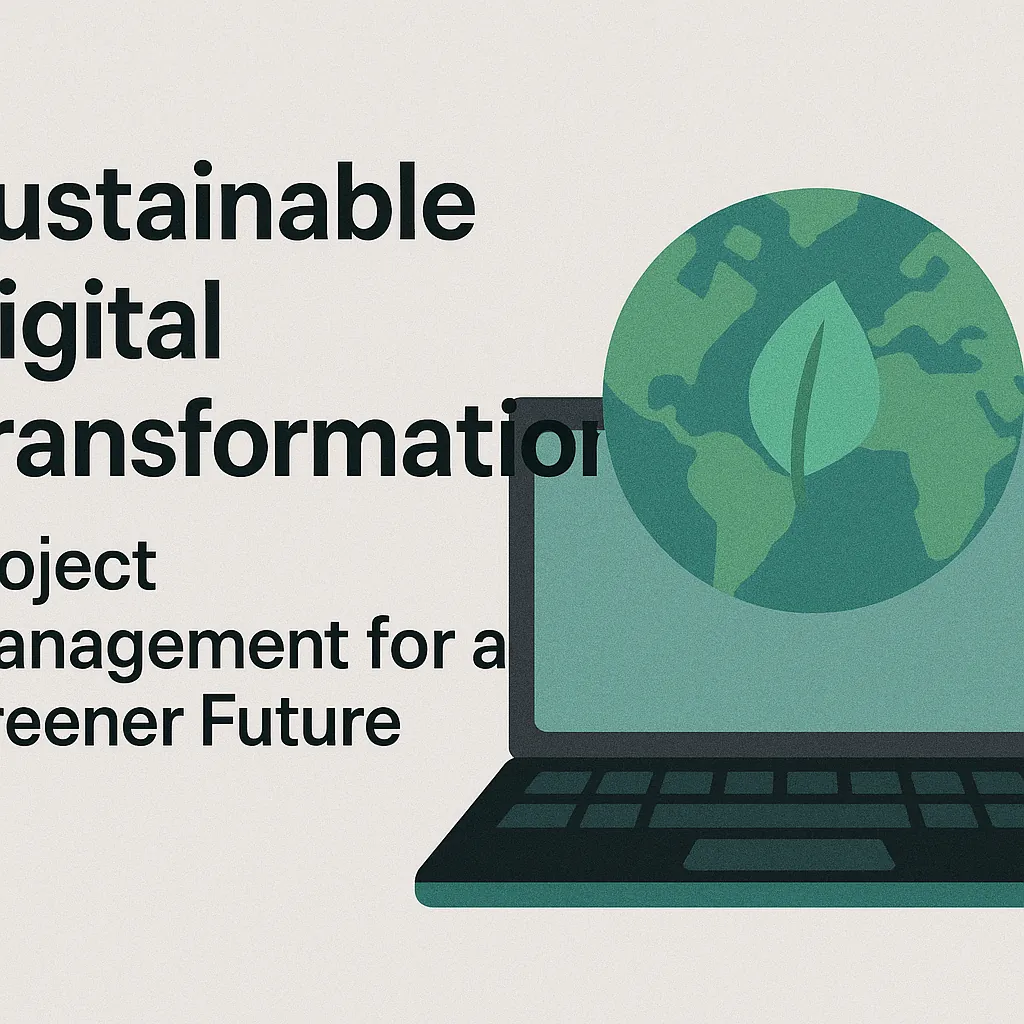Introduction to Sustainable Digital Transformation
Digital transformation has emerged as a critical strategy for organizations seeking to enhance efficiency, improve customer experiences, and remain competitive. Digital transformation refers to the integration of digital technology into all areas of a business, fundamentally changing how it operates and delivers value to customers. This shift is not merely about adopting new technologies; it encompasses a cultural change that requires organizations to continually challenge the status quo, experiment, and become comfortable with failure. As businesses increasingly rely on digital solutions, the relevance of digital transformation becomes more pronounced, especially in the wake of global challenges such as climate change and resource scarcity.
Sustainability has become a pivotal consideration in the context of digital transformation. It involves meeting the needs of the present without compromising the ability of future generations to meet their own needs. In the realm of digital transformation, sustainability can manifest in various ways, including reducing carbon footprints through efficient resource management, leveraging technology to promote sustainable practices, and ensuring that digital initiatives contribute positively to social and environmental outcomes. As organizations embark on their digital transformation journeys, integrating sustainability into these initiatives is not just a moral imperative but also a strategic advantage.
The necessity of incorporating sustainability into project management for digital transformation initiatives cannot be overstated. Project managers play a crucial role in ensuring that sustainability is woven into the fabric of digital transformation projects. This integration is essential for several reasons:
- Long-term Success: Projects that prioritize sustainability are more likely to achieve long-term success. By considering environmental and social impacts, organizations can mitigate risks and enhance their reputation, leading to increased stakeholder trust and loyalty.
- Regulatory Compliance: As governments and regulatory bodies worldwide impose stricter sustainability standards, integrating these considerations into project management helps organizations stay compliant and avoid potential penalties.
- Innovation and Efficiency: Sustainable practices often drive innovation, leading to more efficient processes and cost savings. By embracing sustainability, project managers can foster a culture of creativity and continuous improvement within their teams.
- Stakeholder Engagement: Engaging stakeholders in sustainability efforts can enhance collaboration and support for digital transformation initiatives. This engagement is vital for ensuring that projects align with broader organizational goals and community expectations.
Understanding the Relationship Between Project Management and Sustainability
The integration of sustainability into digital transformation initiatives is not just a trend but a necessity. Effective project management plays a crucial role in guiding organizations toward sustainable practices, ensuring that digital transformation efforts contribute positively to the environment and society. Here are some key points that illustrate this relationship:
The Role of Project Management in Guiding Sustainable Initiatives
- Strategic Alignment: Project management provides a structured approach to align sustainability goals with organizational objectives. By integrating sustainability into project planning and execution, project managers can ensure that initiatives not only meet business needs but also contribute to environmental and social goals.
- Stakeholder Engagement: Effective project management involves engaging stakeholders at all levels. This engagement is vital for understanding the sustainability concerns of various stakeholders, including employees, customers, and the community. By fostering collaboration, project managers can identify sustainable solutions that resonate with all parties involved.
- Risk Management: Sustainability initiatives often come with unique risks, such as regulatory compliance and reputational impacts. Project management equips teams with the tools to identify, assess, and mitigate these risks, ensuring that sustainability efforts are not only ambitious but also feasible and responsible.
Principles of Sustainable Project Management
- Triple Bottom Line Approach: Sustainable project management emphasizes the triple bottom line—people, planet, and profit. This approach encourages project managers to consider social, environmental, and economic impacts throughout the project lifecycle, leading to more balanced and responsible decision-making.
- Lifecycle Thinking: Incorporating lifecycle thinking into project management means considering the entire lifecycle of a project, from conception to disposal. This principle helps identify opportunities for reducing waste, improving resource efficiency, and enhancing the sustainability of project outcomes.
- Continuous Improvement: Sustainable project management promotes a culture of continuous improvement. By regularly assessing project performance against sustainability metrics, project managers can identify areas for enhancement and implement best practices that drive long-term sustainability.
Incorporating Sustainable Practices into Project Management Methodologies
- Agile Methodologies: Agile project management can be adapted to prioritize sustainability by incorporating sustainability goals into sprint planning and reviews. Teams can set specific sustainability targets for each iteration, allowing for flexibility and responsiveness to changing environmental needs.
- Waterfall Methodologies: In traditional waterfall methodologies, sustainability can be integrated by ensuring that each phase of the project includes sustainability assessments. For instance, during the planning phase, project managers can evaluate the environmental impact of proposed solutions and make adjustments accordingly.
- Hybrid Approaches: Combining elements of both agile and waterfall methodologies can create a robust framework for sustainable project management. This hybrid approach allows for structured planning while maintaining the flexibility to adapt to sustainability challenges as they arise.
Key Components of Sustainable Digital Transformation Projects
Particularly within digital transformation initiatives, integrating sustainability is becoming increasingly vital. For Sustainability Officers and Project Managers, understanding the key components that ensure sustainability is prioritized can lead to more effective and responsible project outcomes. Here are the essential elements to consider:
1. Stakeholder Engagement and Collaboration
- Inclusive Participation: Engaging stakeholders from the outset is crucial. This includes not only project team members but also clients, end-users, and community representatives. Their insights can help shape a project that aligns with sustainability goals and addresses the needs of all parties involved.
- Collaborative Frameworks: Establishing a collaborative environment fosters innovation and shared responsibility. Utilizing tools and platforms that facilitate communication and collaboration can enhance stakeholder involvement and ensure that sustainability considerations are integrated throughout the project lifecycle.
2. Setting Measurable Sustainability Goals
- SMART Objectives: Goals should be Specific, Measurable, Achievable, Relevant, and Time-bound (SMART). This approach allows project managers to track progress and make necessary adjustments. For instance, setting targets for reducing carbon emissions or increasing energy efficiency can provide clear benchmarks for success.
- Regular Assessment: Implementing a framework for regular assessment of sustainability goals ensures that the project remains aligned with its objectives. This could involve periodic reviews and adjustments based on performance metrics, stakeholder feedback, and emerging best practices in sustainability.
3. Integration of Green Technologies and Practices
- Adopting Eco-Friendly Solutions: Incorporating green technologies, such as renewable energy sources, energy-efficient systems, and sustainable materials, is essential. This not only reduces the environmental impact of the project but can also lead to cost savings in the long run.
- Sustainable Practices: Beyond technology, adopting sustainable practices in project management—such as minimizing waste, optimizing resource use, and promoting remote work—can significantly enhance the sustainability of digital transformation projects. Training team members on these practices can further embed sustainability into the project culture.
By focusing on these key components, project managers can ensure that sustainability is not just an afterthought but a fundamental aspect of digital transformation initiatives. This approach not only contributes to a greener future but also enhances the overall success and resilience of projects in an increasingly eco-conscious market.
Best Practices for Integrating Sustainability into Digital Transformation Project Management
In the era of digital transformation, integrating sustainability into project management is not just a trend but a necessity. Sustainability Officers and Project Managers play a crucial role in ensuring that digital initiatives contribute positively to the environment and society. Here are some actionable strategies to effectively integrate sustainability into digital transformation project management.
1. Frameworks for Assessing Sustainability Impact
To assess the sustainability impact of digital transformation projects, consider implementing the following frameworks:
- Triple Bottom Line (TBL): This framework evaluates projects based on three pillars: social, environmental, and economic. By assessing how a project affects each of these areas, project managers can make informed decisions that align with sustainability goals.
- Sustainable Development Goals (SDGs): Aligning project objectives with the United Nations’ SDGs can help ensure that digital transformation efforts contribute to global sustainability targets. This alignment can guide project scope, stakeholder engagement, and outcome measurement.
- Life Cycle Assessment (LCA): Utilizing LCA allows project managers to evaluate the environmental impacts of a project throughout its entire life cycle, from conception to disposal. This comprehensive approach helps identify areas for improvement and innovation.
2. Tools and Technologies for Sustainable Project Management
Several tools and technologies can facilitate sustainable project management in digital transformation initiatives:
- Project Management Software with Sustainability Features: Tools like Asana, Trello, and Microsoft Project can be enhanced with plugins or features that track sustainability metrics, such as carbon footprint, resource usage, and waste generation.
- Data Analytics and Reporting Tools: Utilizing data analytics platforms can help project managers monitor sustainability performance in real-time. Tools like Tableau or Power BI can visualize data related to energy consumption, resource allocation, and project outcomes.
- Collaboration Platforms: Tools such as Slack or Microsoft Teams can enhance communication among project stakeholders, ensuring that sustainability considerations are integrated into every phase of the project. These platforms can also facilitate knowledge sharing about best practices in sustainability.
Challenges and Solutions in Sustainable Digital Transformation Project Management
Integrating sustainability into project management presents unique challenges. Sustainability Officers and Project Managers must navigate these obstacles to ensure that their initiatives not only drive technological advancement but also contribute positively to the environment. Below are some common challenges faced in sustainable digital transformation project management, along with effective solutions and strategies to overcome them.
Common Challenges
- Resistance to Change: Many organizations face internal resistance when implementing new digital processes, especially those that require a shift in mindset towards sustainability. Employees may be accustomed to traditional methods and skeptical about the benefits of digital transformation.
- Budget Constraints: Sustainable initiatives often require upfront investment, which can be a significant barrier. Project managers may struggle to secure funding for projects that prioritize sustainability alongside digital transformation.
- Lack of Expertise: There is often a gap in knowledge regarding sustainable practices within digital transformation. Project teams may lack the necessary skills to implement sustainable solutions effectively, leading to suboptimal outcomes.
Effective Solutions and Strategies
Fostering a Culture of Change:
To combat resistance, it is crucial to cultivate a culture that embraces change. This can be achieved through:
- Engagement and Communication: Regularly communicate the benefits of sustainable digital transformation to all stakeholders. Use success stories and data to illustrate the positive impact on both the organization and the environment.
- Training and Workshops: Provide training sessions that focus on the importance of sustainability in digital projects, helping employees understand their role in the transformation process.
Strategic Budgeting and Resource Allocation:
Addressing budget constraints requires innovative financial strategies:
- Cost-Benefit Analysis: Conduct thorough analyses to demonstrate the long-term savings and benefits of sustainable practices, which can help in justifying initial investments.
- Leveraging Grants and Partnerships: Explore grants, subsidies, or partnerships with organizations focused on sustainability to alleviate financial burdens.
Building Expertise through Collaboration:
To overcome the lack of expertise, organizations can:
- Collaborate with Experts: Partner with sustainability consultants or organizations that specialize in sustainable digital transformation. This can provide valuable insights and guidance.
- Continuous Learning Programs: Implement ongoing training and development programs that focus on both digital skills and sustainability practices. Encourage team members to pursue certifications in sustainable project management.
Importance of Continuous Learning and Adaptation
In the fast-evolving landscape of digital transformation, continuous learning and adaptation are paramount. Organizations must remain agile and responsive to new technologies and sustainability practices. This involves:
- Regularly Updating Skills: Encourage project teams to stay informed about the latest trends in digital transformation and sustainability through workshops, webinars, and industry conferences.
- Feedback Loops: Establish mechanisms for feedback and reflection on project outcomes. This allows teams to learn from successes and failures, fostering a culture of improvement and innovation.
By addressing these challenges with targeted solutions, organizations can successfully integrate sustainability into their digital transformation project management efforts, paving the way for a greener future.
Measuring Success: KPIs and Metrics for Sustainable Digital Transformation
Integrating sustainability into project management is not just a trend; it is a necessity for organizations aiming to thrive in a rapidly changing environment. For Sustainability Officers and Project Managers, understanding how to measure the success of these initiatives through relevant Key Performance Indicators (KPIs) and metrics is crucial. This section will outline essential KPIs, methods for tracking sustainability outcomes, and the importance of transparency and accountability in evaluating project success.
Defining Key Performance Indicators (KPIs) Relevant to Sustainability
To effectively measure the impact of digital transformation projects on sustainability, it is essential to establish clear KPIs. These indicators should align with both organizational goals and broader sustainability objectives. Here are some key KPIs to consider:
- Carbon Footprint Reduction: Measure the decrease in greenhouse gas emissions resulting from digital initiatives, such as cloud computing or energy-efficient technologies.
- Resource Efficiency: Track the reduction in resource consumption (e.g., energy, water, materials) achieved through digital processes, indicating improved operational efficiency.
- Waste Reduction: Monitor the decrease in waste generated by digital transformation efforts, including e-waste from outdated technologies and materials used in production.
- Stakeholder Engagement: Evaluate the level of engagement and satisfaction among stakeholders, including employees, customers, and the community, regarding sustainability initiatives.
- Sustainable Innovation: Assess the number of new sustainable products or services developed as a result of digital transformation efforts.
Tracking and Reporting on Sustainability Outcomes
Once KPIs are defined, the next step is to implement systems for tracking and reporting on these sustainability outcomes. Effective tracking involves:
- Data Collection: Utilize digital tools and platforms to gather data on sustainability metrics. This can include software for energy management, waste tracking, and carbon accounting.
- Regular Reporting: Establish a routine for reporting sustainability outcomes to stakeholders. This could be through quarterly reports, dashboards, or sustainability scorecards that highlight progress against KPIs.
- Benchmarking: Compare performance against industry standards or best practices to gauge the effectiveness of sustainability initiatives. This can help identify areas for improvement and drive competitive advantage.
Importance of Transparency and Accountability
Transparency and accountability are vital components of measuring success in sustainable digital transformation. Organizations should:
- Communicate Results: Share sustainability outcomes openly with all stakeholders, including employees, customers, and investors. This fosters trust and demonstrates commitment to sustainability goals.
- Set Clear Accountability: Assign responsibility for achieving sustainability KPIs to specific team members or departments. This ensures that there is ownership of the outcomes and encourages proactive management of sustainability initiatives.
- Continuous Improvement: Use the insights gained from tracking and reporting to refine strategies and processes. This iterative approach allows organizations to adapt and enhance their sustainability efforts over time.
Future Trends in Sustainable Digital Transformation Project Management
As organizations increasingly recognize the importance of sustainability, the integration of sustainable practices into digital transformation project management is becoming essential. This section explores emerging trends in technology that promote sustainability, the role of advanced technologies like AI, IoT, and data analytics, and predictions for future developments in regulations and market expectations.
Emerging Trends in Technology Promoting Sustainability
- Green Cloud Computing: The shift towards cloud computing is not just about efficiency; it also offers significant environmental benefits. By utilizing shared resources, organizations can reduce their carbon footprint. Cloud providers are increasingly adopting renewable energy sources, making it easier for businesses to align their digital transformation efforts with sustainability goals.
- Sustainable Software Development: The rise of DevOps and Agile methodologies is fostering a culture of continuous improvement, which can be leveraged to enhance sustainability. By focusing on energy-efficient coding practices and optimizing software for lower resource consumption, organizations can minimize the environmental impact of their digital solutions.
- Circular Economy Technologies: Innovations that support the circular economy, such as blockchain for supply chain transparency and product lifecycle management, are gaining traction. These technologies help organizations track resource usage and waste, enabling more sustainable project management practices.
Role of AI, IoT, and Data Analytics
- Artificial Intelligence (AI): AI can significantly enhance sustainable project management by optimizing resource allocation and predicting project outcomes. Machine learning algorithms can analyze vast amounts of data to identify inefficiencies and suggest improvements, leading to more sustainable practices.
- Internet of Things (IoT): IoT devices provide real-time data that can be used to monitor energy consumption, waste production, and resource usage. This data enables project managers to make informed decisions that align with sustainability goals, such as reducing energy use in real-time or optimizing logistics to minimize carbon emissions.
- Data Analytics: Advanced data analytics tools allow organizations to assess the environmental impact of their projects comprehensively. By analyzing historical data and current trends, project managers can identify areas for improvement and implement strategies that enhance sustainability throughout the project lifecycle.
Future Developments in Regulations and Market Expectations
- Increased Regulatory Scrutiny: As governments worldwide prioritize sustainability, regulations are expected to become more stringent. Project managers will need to stay informed about evolving compliance requirements related to environmental impact, carbon emissions, and resource management.
- Market Demand for Sustainable Practices: Consumers and stakeholders are increasingly favoring companies that demonstrate a commitment to sustainability. This shift in market expectations will drive organizations to adopt sustainable practices in their digital transformation projects, making it a competitive advantage.
- Integration of ESG Metrics: Environmental, Social, and Governance (ESG) metrics are becoming critical in project evaluation. Future project management frameworks will likely incorporate these metrics to assess the sustainability of projects, influencing decision-making and resource allocation.
Conclusion
The integration of sustainability into digital transformation project management is not just a trend; it is a necessity. As organizations strive to adapt to new technologies and processes, they must also consider the environmental and social impacts of their initiatives. Here are the key takeaways to remember:
- Importance of Sustainability Integration: The convergence of digital transformation and sustainability is crucial for fostering long-term resilience and success. By embedding sustainable practices into digital projects, organizations can reduce their carbon footprint, enhance resource efficiency, and contribute positively to their communities. This holistic approach not only meets regulatory requirements but also aligns with the growing expectations of stakeholders and consumers who prioritize environmental responsibility.
- Collaboration is Key: Effective digital transformation requires a collaborative effort between sustainability officers and project managers. By working together, these professionals can ensure that sustainability goals are integrated into every phase of project management—from planning and execution to monitoring and evaluation. This partnership can lead to innovative solutions that balance technological advancement with ecological stewardship, ultimately driving more impactful outcomes.
Actionable Next Steps: To implement sustainable practices in your digital transformation projects, consider the following actionable steps:
- Conduct a Sustainability Assessment: Evaluate the environmental impact of your current digital initiatives and identify areas for improvement.
- Set Clear Sustainability Goals: Define specific, measurable objectives related to sustainability that align with your organization’s overall mission.
- Leverage Technology for Sustainability: Utilize digital tools and platforms that promote sustainability, such as energy-efficient software solutions and data analytics for resource optimization.
- Engage Stakeholders: Involve all relevant stakeholders, including employees, customers, and suppliers, in discussions about sustainability to foster a culture of shared responsibility.
- Monitor and Report Progress: Establish metrics to track the effectiveness of your sustainability initiatives and communicate progress transparently to stakeholders.
By taking these proactive steps, sustainability officers and project managers can lead the charge toward a greener future, ensuring that digital transformation efforts contribute positively to both business success and environmental stewardship. Embrace the opportunity to make a difference—together, we can create a sustainable digital landscape that benefits everyone.
Find out more about Shaun Stoltz https://www.shaunstoltz.com/about/.
This post was written by an AI and reviewed/edited by a human.



